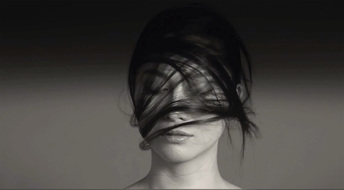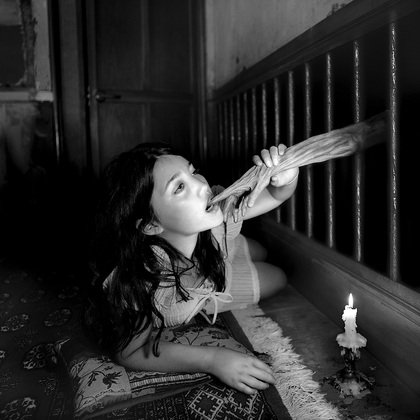-
From Current Issue
-
- Editor’s Letter Fire in the Heart
- Reviews I Gusti Ayu Kadek Murniasih
- Reviews 11th Seoul Mediacity Biennale: “One Escape at a Time”
- Dispatch Networked China
- One on One Monira Al Qadiri on Yukio Mishima
- Essays The rise of independent art spaces in pandemic-era Shanghai
- Features Tuan Andrew Nguyen
- Table of Contents
- Web Exclusives
- Archive
- Subscribe

R
E
V N
E
X
T
Installation view of “Japan Supernatural,” at Art Gallery of New South Wales, Sydney, 2020. Photo by Jenni Carter. Courtesy Art Gallery of New South Wales.
Ghosts hover, demons cling to dismembered limbs, and blood is spilled in the woodblock prints, silk scrolls, photographs, paintings, and netsuke of the blockbuster exhibition “Japan Supernatural.” Presented by Sydney’s Art Gallery of New South Wales, the show was a revelry with the fiendish grotesques that have stalked the Japanese imagination from the Edo period (1603–1868) through to the present day.
The exhibition included pieces by several master artists. Among them, Toriyama Sekien’s (1712–88) woodblock-printed book Night Procession of the Hundred Demons (1776) could be seen as a precursor to contemporary manga—such as the series Gegege no Kitaro by Shigeru Mizuki, popularized in the 1960s—in its form and depictions of mischievous imps.
This connection between traditional compositions and contemporary works was evident elsewhere. Similarly bearing influence on the works of today’s artists are Kuniyoshi Utagawa’s (1798–1861) vivid scenes from history and legend, exemplified in the show by his 1845–46 print of a skeleton looming over a samurai about to behead a traitor. Utagawa’s use of fantastical scale was reflected in Takashi Murakami’s commissioned multipanel painting. At ten meters wide and three meters tall, Japan Supernatural: Vertiginous After Staring at the Empty World Too Intensely, I Found Myself Trapped in the Realm of Lurking Ghosts and Monsters (2019) features a gargantuan cat with crazed eyes who dwarfs a battle between a group of samurai and yokai (spirits). While the warriors flash their glittering blades, it appears that the devils are the ones gaining the advantage in this eternal fight, symbolically evoking the artist’s commentary on the dismal state of the world.
Installation view of TAKASHI MURAKAMI’s (front, left to right) Embodiment of “Um” and Embodiment of “A”, 2014, FRP, stainless steel, zelkova wood, and acrylic, dimensions variable; and (back) Japan Supernatural: Vertiginous After Staring at the Empty World Too Intensely, I Found Myself Trapped in the Realm of Lurking Ghosts and Monsters, 2019, acrylic resin paint, gold leaf, glitter, 300 × 1000 cm, at “Japanese Supernatural,” Art Gallery of New South Wales, Sydney, 2020. Copyright Takashi Murakami/Kaikai Kiki Co., Ltd. All Rights Reserved. Photo by Jenni Carter. Courtesy the artist; Kaikai Kiki Co., Ltd.; and Art Gallery of New South Wales.
In the same cavernous room were two towering sculptures by Murakami of sinewy, horned demons. As with their predecessors in traditional images, and with the characters of manga and anime, their dramatic facial expressions are simultaneously ferocious and comical, capturing the blend of absurdist humor and horror that Japanese renderings of the supernatural often evidence. Murakami’s other behemoth painting In the Land of the Dead, Stepping on the Tail of a Rainbow (2014) hinted at the conceptual depth behind the artist’s ghoulish figures. Created following the 2011 Tohoku earthquake, the work shows arhats among pools of vividly colored churning water, alluding to the suffering of the world even as one seeks enlightenment.
Some of the standout contemporary displays were by Fuyuko Matsui, who specializes in Nihonga, and deals in a quiet and unassuming way with the female experience of death and physical decay. Her black-and-white video Regeneration of a breached thought (2012) has an aesthetic stillness that contrasts an elegant, blind Borzoi dog with a close-up of Matsui’s own face entangled in strands of her black hair, which wind around her like a suffocating vine.
While Matsui’s work is contemplative, almost serene, the monochrome photographic series Fairy tale (2004–06) by Miwa Yanagi returned viewers to a world of horror, with scenes from European fairy tales recast with old and young women. The gruesome mise-en-scènes comment on intergenerational conflicts, an issue particularly pertinent in Japan, known for its “super-aging” society.
The strength of “Japan Supernatural” was its sweeping perspective, which spanned 300-years of history. From processions of macabre creatures to ethereal female phantoms, audiences were treated to a potent conjuring of the spirit-world, as imagined through the ages.
Michael Young is a contributing editor of ArtAsiaPacific.
“Japan Supernatural” is on view at the Art Gallery of New South Wales, Sydney, until March 8, 2020.
To read more of ArtAsiaPacific’s articles, visit our Digital Library.



















